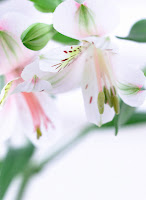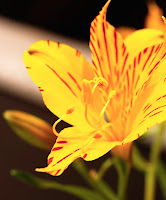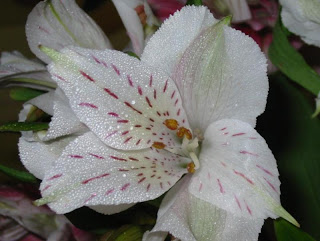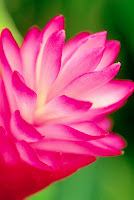Alstroemeria (Peruvian lily, Inca Lily) Meaning
MeaningWealth, prosperity, fortune
OriginsOf South American origin, alstroemeria--also known as Peruvian lily--is a member of the Amaryllidaceae family and is related to the onion, daffodil, agapanthus and nerine. Brought to Europe in the 18th century to be named by the renowned botanist Carl Linnaeus, alstroemerias are now grown internationally.
Availability and Vase LifeReadily available in ample supply year-round, alstroemerias come in a wide range of colors, including white, pink, yellow, salmon, red, lavender, orange, bronze and bicolors.
They're ethylene-sensitive flowers, but with proper care and handling, alstroemerias may attain a vase life of 6-14 days, depending upon the cultivar. Avoid buying flowers with yellowing or transparent leaves; these are signs of ethylene damage.
 Care and Handling
Care and HandlingTrim stems under water. Place flowers in a clean container containing a properly prepared solution of fresh flower food. Avoid using water with high fluoride levels, if possible, since alstroemerias are susceptible to fluoride damage.
 Design Uses
Design UsesAlstroemerias are exceedingly versatile flowers--in terms of both color and form. Always a perfect color highlight for seasonal vase arrangements, they also serve as lovely line flowers in more contemporary arrangements, and--in a short-stemmed cluster--as vivid focal areas. Stripping the foliage is often advisable, since it will yellow long before the flowers fade.
Alstroemeria Peregrina
 AlstroemeriaFrom Wikipedia, the free encyclopedia:
AlstroemeriaFrom Wikipedia, the free encyclopedia: Alstroemeria
Alstroemeria (syn.
Alstremeria), commonly called the
Peruvian Lily or
Lily of the Incas, is a South American genus of about 50 species of flowering plants. Almost all of the species are restricted to one of two distinct centers of diversity, one in central Chile, the other in eastern Brazil. Species of Alstroemeria from Chile are winter-growing plants while those of Brazil are summer-growing. All are long-lived perennials except A. (Taltalia) graminea, a diminutive annual from the Atacama Desert of Chile.

The genus was named for the Swedish baron Clas Alströmer (Claus von Alstroemer) by his close friend Carolus Linnaeus. The plant was first described by the French botanist Louis Feuillée. The plant's seeds were among many collected by Alströmer on a trip to South America in 1753.
The plants are distinctive vegetatively, with a rootstock consisting of a slender rhizome or group of rhizomes (the "crown"). Storage roots consist of sausage-like water storing structures "suspended" from the rhizome by major roots. In this way the root system resembles that of dahlias. Above-ground shoots may be very short in some alpine Andean species (a few cm tall) or up to about 1.5 m tall in other species. Each year (more often in some hybrids) up to 80 new shoots are produced from the rootstock and each terminates in an umbel of a few up to 10 or so flowers.

Perhaps the most fascinating- and telltale- morphological trait of
Alstroemeria and its relatives is the fact that the leaves are resupinate, that is, they twist from the base so that what appears to be the upper leaf surface is in fact the lower leaf surface. This very unusual botanical feature is easily observed in the leaves on cut flowers from the florist.
The
flowers of Alstroemeria are generally showy and appear to be suited to pollination by bees (?). All six tepals (tepal denotes either petal or sepal when both are similar, as in lilies, amaryllis, etc.) are roughly similar. In some species two tepals are enlarged and vividly colored and act as "flags" for pollination. The ovary is inferior and the seeds are hard and rounded.

See also
Bomarea, the other major genus in the Alstroemeriaceae. They are essentially twining alstroemerias (though some species are upright), with most species occurring in the Andes.
Selected species:
Alstroemeria aurea -
Lily of the Incas.
Alstroemeria aurantiaca -
Peruvian LilyAlstroemeria caryophyllacea -
Brazilian LilyAlstroemeria haemantha -
Purplespot Parrot LilyAlstroemeria ligtu -
Lily-of-the-NileAlstroemeria psittacina -
Lily of the Incas,
White-edged Peruvian LilyAlstroemeria pulchella -
Parrot Lily,
Parrot Flower, Red Parrot Beak, New Zealand Christmas BellCultivation and usesAlstroemeria ligtu
Alstroemeria ligtu
Many hybrids and about 190 cultivars have been developed, with different markings and colors, ranging from white, golden yellow, orange, to apricot, pink, red, purple and lavender. The most popular and showy hybrids commonly grown today result from crosses between species from Chile (winter-growing) with species from Brazil (summer-growing). This strategy has overcome the problem of seasonal dormancy and resulted in plants that are evergreen or nearly so and flower for most of the year. This breeding work derives mainly from trials that began in the United States in the 1980s. The flower, which resembles a miniature lily, is very popular for bouquets and flower arrangements in the commercial cut flower trade. They have a vase life of about two weeks. It is sometimes called '
Ulster Mary' (as a word corruption).
 Other published namesAlstroemeria achirae, Alstroemeria albiflora, Alstroemeria altoparadisea, Alstroemeria amazonica, Alstroemeria anajeana, Alstroemeria anceps, Alstroemeria angustifolia, Alstroemeria annapolina, Alstroemeria apertiflora, Alstroemeria aquidauanica, Alstroemeria araucana, Alstroemeria argento-vittata, Alstroemeria arnicana, Alstroemeria atrorubra, Alstroemeria aulica, Alstroemeria aurantiaca, Alstroemeria bahiensis, Alstroemeria bakeri, Alstroemeria berteroiana, Alstroemeria bilabiata, Alstroemeria bracteata, Alstroemeria brasiliensis, Alstroemeria burchellii, Alstroemeria butantanensis, Alstroemeria caiaponica, Alstroemeria campaniflora, Alstroemeria cantillanica, Alstroemeria caudiculata, Alstroemeria chapadensis, Alstroemeria chilensis, Alstroemeria chillanensis, Alstroemeria chiloensis, Alstroemeria chorillensis, Alstroemeria ciliata, Alstroemeria cordifolia, Alstroemeria crispata, Alstroemeria cuiabana, Alstroemeria cultrifolia, Alstroemeria cunea, Alstroemeria curralensis, Alstroemeria damaziana, Alstroemeria decora, Alstroemeria denticulata, Alstroemeria despuenta, Alstroemeria diazi, Alstroemeria didierana, Alstroemeria diluta, Alstroemeria discolor, Alstroemeria distichifolia, Alstroemeria douradensis, Alstroemeria edulis, Alstroemeria epulauquensis, Alstroemeria espigonensis, Alstroemeria fiebrieiana, Alstroemeria firmulifolia, Alstroemeria flava, Alstroemeria floribunda, Alstroemeria fluminensis, Alstroemeria foliosa, Alstroemeria fuscovinosa, Alstroemeria garaventae, Alstroemeria gardneri, Alstroemeria gayana, Alstroemeria glaucandra, Alstroemeria graminea, Alstroemeria grandifolia, Alstroemeria hassleriana, Alstroemeria huemulina, Alstroemeria hygrophila, Alstroemeria ibitipocae, Alstroemeria igarapavica, Alstroemeria inaequalis, Alstroemeria inconspicua, Alstroemeria inodora, Alstroemeria insignis, Alstroemeria involucrosa, Alstroemeria isabellana, Alstroemeria itabiritensis, Alstroemeria itatiaica, Alstroemeria jacobi, Alstroemeria jequitiana, Alstroemeria jocunda, Alstroemeria kunziana, Alstroemeria lacrima-solis, Alstroemeria lactilutea, Alstroemeria latifolia, Alstroemeria lineatiflora, Alstroemeria litterata, Alstroemeria longaviensis, Alstroemeria longistaminea, Alstroemeria longistyla, Alstroemeria lutea, Alstroemeria macraeana, Alstroemeria macrocarpa, Alstroemeria magenta, Alstroemeria magna, Alstroemeria magnifica, Alstroemeria malmeana, Alstroemeria meyeniana, Alstroemeria modesta, Alstroemeria monantha, Alstroemeria monticola, Alstroemeria mutabilis, Alstroemeria nana, Alstroemeria nervosa, Alstroemeria nidularis, Alstroemeria nubigena, Alstroemeria ochagavii, Alstroemeria odorata, Alstroemeria orchidioides, Alstroemeria oreas, Alstroemeria pallens, Alstroemeria parviflora, Alstroemeria parvula, Alstroemeria patagonica, Alstroemeria pauciflora, Alstroemeria paupercula, Alstroemeria pavoniana, Alstroemeria pelegrina, Alstroemeria philippii, Alstroemeria piauhyensis, Alstroemeria plantaginea, Alstroemeria platyphylla, Alstroemeria poetica, Alstroemeria polpaicana, Alstroemeria polyphylla, Alstroemeriapubiflora, Alstroemeria pudica, Alstroemeria punctata, Alstroemeria pygmaea, Alstroemeria radula, Alstroemeria reclinata, Alstroemeria reflexa, Alstroemeria regnelliana, Alstroemeria revoluta, Alstroemeria riedelliana, Alstroemeria rosea, Alstroemeria roseoviridis, Alstroemeria rubra, Alstroemeria sabulosa, Alstroemeria salsilloides, Alstroemeria scaberula, Alstroemeria schenkiana, Alstroemeria schizanthoides, Alstroemeria sellowiana, Alstroemeria sierrae, Alstroemeria sotoana, Alstroemeria soukupii, Alstroemeria spathulata, Alstroemeria spectabilis, Alstroemeria stenopetala, Alstroemeria subrosulacea, Alstroemeria talcaensis, Alstroemeria timida, Alstroemeria umbrosa, Alstroemeria venusta, Alstroemeria versicolor, Alstroemeria violacea, Alstroemeria virginalis, Alstroemeria viridiflora, Alstroemeria volckmanni, Alstroemeria werdermannii, Alstroemeria xanthina, Alstroemeria xavantinensis, Alstroemeria yaelae, Alstroemeria zamioides, Alstroemeria zoelneri.
Other published namesAlstroemeria achirae, Alstroemeria albiflora, Alstroemeria altoparadisea, Alstroemeria amazonica, Alstroemeria anajeana, Alstroemeria anceps, Alstroemeria angustifolia, Alstroemeria annapolina, Alstroemeria apertiflora, Alstroemeria aquidauanica, Alstroemeria araucana, Alstroemeria argento-vittata, Alstroemeria arnicana, Alstroemeria atrorubra, Alstroemeria aulica, Alstroemeria aurantiaca, Alstroemeria bahiensis, Alstroemeria bakeri, Alstroemeria berteroiana, Alstroemeria bilabiata, Alstroemeria bracteata, Alstroemeria brasiliensis, Alstroemeria burchellii, Alstroemeria butantanensis, Alstroemeria caiaponica, Alstroemeria campaniflora, Alstroemeria cantillanica, Alstroemeria caudiculata, Alstroemeria chapadensis, Alstroemeria chilensis, Alstroemeria chillanensis, Alstroemeria chiloensis, Alstroemeria chorillensis, Alstroemeria ciliata, Alstroemeria cordifolia, Alstroemeria crispata, Alstroemeria cuiabana, Alstroemeria cultrifolia, Alstroemeria cunea, Alstroemeria curralensis, Alstroemeria damaziana, Alstroemeria decora, Alstroemeria denticulata, Alstroemeria despuenta, Alstroemeria diazi, Alstroemeria didierana, Alstroemeria diluta, Alstroemeria discolor, Alstroemeria distichifolia, Alstroemeria douradensis, Alstroemeria edulis, Alstroemeria epulauquensis, Alstroemeria espigonensis, Alstroemeria fiebrieiana, Alstroemeria firmulifolia, Alstroemeria flava, Alstroemeria floribunda, Alstroemeria fluminensis, Alstroemeria foliosa, Alstroemeria fuscovinosa, Alstroemeria garaventae, Alstroemeria gardneri, Alstroemeria gayana, Alstroemeria glaucandra, Alstroemeria graminea, Alstroemeria grandifolia, Alstroemeria hassleriana, Alstroemeria huemulina, Alstroemeria hygrophila, Alstroemeria ibitipocae, Alstroemeria igarapavica, Alstroemeria inaequalis, Alstroemeria inconspicua, Alstroemeria inodora, Alstroemeria insignis, Alstroemeria involucrosa, Alstroemeria isabellana, Alstroemeria itabiritensis, Alstroemeria itatiaica, Alstroemeria jacobi, Alstroemeria jequitiana, Alstroemeria jocunda, Alstroemeria kunziana, Alstroemeria lacrima-solis, Alstroemeria lactilutea, Alstroemeria latifolia, Alstroemeria lineatiflora, Alstroemeria litterata, Alstroemeria longaviensis, Alstroemeria longistaminea, Alstroemeria longistyla, Alstroemeria lutea, Alstroemeria macraeana, Alstroemeria macrocarpa, Alstroemeria magenta, Alstroemeria magna, Alstroemeria magnifica, Alstroemeria malmeana, Alstroemeria meyeniana, Alstroemeria modesta, Alstroemeria monantha, Alstroemeria monticola, Alstroemeria mutabilis, Alstroemeria nana, Alstroemeria nervosa, Alstroemeria nidularis, Alstroemeria nubigena, Alstroemeria ochagavii, Alstroemeria odorata, Alstroemeria orchidioides, Alstroemeria oreas, Alstroemeria pallens, Alstroemeria parviflora, Alstroemeria parvula, Alstroemeria patagonica, Alstroemeria pauciflora, Alstroemeria paupercula, Alstroemeria pavoniana, Alstroemeria pelegrina, Alstroemeria philippii, Alstroemeria piauhyensis, Alstroemeria plantaginea, Alstroemeria platyphylla, Alstroemeria poetica, Alstroemeria polpaicana, Alstroemeria polyphylla, Alstroemeriapubiflora, Alstroemeria pudica, Alstroemeria punctata, Alstroemeria pygmaea, Alstroemeria radula, Alstroemeria reclinata, Alstroemeria reflexa, Alstroemeria regnelliana, Alstroemeria revoluta, Alstroemeria riedelliana, Alstroemeria rosea, Alstroemeria roseoviridis, Alstroemeria rubra, Alstroemeria sabulosa, Alstroemeria salsilloides, Alstroemeria scaberula, Alstroemeria schenkiana, Alstroemeria schizanthoides, Alstroemeria sellowiana, Alstroemeria sierrae, Alstroemeria sotoana, Alstroemeria soukupii, Alstroemeria spathulata, Alstroemeria spectabilis, Alstroemeria stenopetala, Alstroemeria subrosulacea, Alstroemeria talcaensis, Alstroemeria timida, Alstroemeria umbrosa, Alstroemeria venusta, Alstroemeria versicolor, Alstroemeria violacea, Alstroemeria virginalis, Alstroemeria viridiflora, Alstroemeria volckmanni, Alstroemeria werdermannii, Alstroemeria xanthina, Alstroemeria xavantinensis, Alstroemeria yaelae, Alstroemeria zamioides, Alstroemeria zoelneri.Source:
Alstroemeria on Wikipedia Encyclopedia


 Origins
Origins
 Design Uses
Design Uses






















